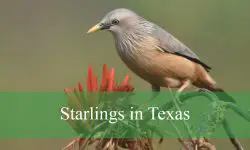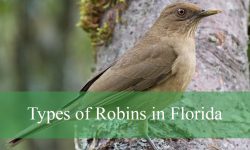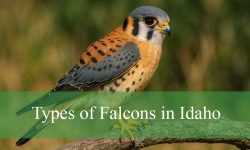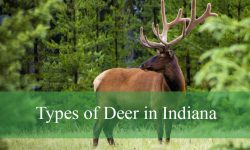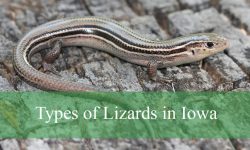Hawks in North Dakota are some of the most fascinating birds of prey found across the state. From the widespread Red-tailed Hawk to the elusive Northern Goshawk, these raptors play a vital role in maintaining healthy ecosystems. Birdwatchers of all levels can enjoy learning to identify these majestic birds and deepen their connection to nature.
The diverse landscapes of North Dakota—including open prairies, grasslands, wetlands, and forests—offer ideal habitats for a variety of hawk species. Hawks in North Dakota can often be seen soaring above fields or perched quietly along river valleys. Each species has unique features and behaviors that make spotting and identifying them a rewarding challenge.
This guide highlights 10 common hawks in North Dakota, featuring pictures and detailed identification tips. By understanding their physical traits, hunting habits, and seasonal patterns, you’ll be better equipped to recognize these impressive raptors in the wild. Let’s explore the fascinating world of Hawks in North Dakota together.
Common Hawks Found in North Dakota
Red-tailed Hawk (Buteo jamaicensis)

The Red-tailed Hawk is the most common and widespread hawk in North Dakota. It is a large bird of prey, measuring between 18 to 26 inches in length, with a wingspan that can reach over 4 feet. Adults are recognizable by their rufous-red tail, broad wings, and pale underside with a streaked belly band. Juveniles lack the red tail and have more brown streaking.
These hawks are powerful fliers and often seen soaring high above open terrain, circling effortlessly on thermals. They’re also frequently spotted perched on fence posts, telephone poles, and trees along roadsides. Their raspy “kee-eee-arr” call is one of the most iconic sounds in North American birding.
Red-tailed Hawks are opportunistic feeders and eat a wide variety of prey, including rodents, rabbits, snakes, and occasionally birds. They hunt both from perches and while in flight, using their excellent vision to spot movement from long distances.
In North Dakota, they inhabit open country such as prairies, pastures, farmlands, and even the edges of wooded areas. These hawks are year-round residents, breeding in spring and staying through harsh winters thanks to their adaptability.
Swainson’s Hawk (Buteo swainsoni)

Swainson’s Hawk is a slender buteo species that migrates to North Dakota in spring. It measures 18 to 22 inches long, with a wingspan of 4 to 4.5 feet. It has long, pointed wings and a pale belly, with a contrasting dark bib across the chest. Plumage can vary, with light and dark morphs both occurring in the region.
These hawks are summer visitors that breed in the northern Great Plains. They are often seen gliding over fields or soaring high in the sky in large migratory groups known as “kettles.” Swainson’s Hawks are highly social during migration and travel thousands of miles to winter in South America.
Their diet is unique among hawks because during the breeding season they primarily hunt insects such as grasshoppers and crickets. They also eat small mammals, birds, and reptiles when insect prey is less available. They often hunt on the ground or from low perches.
In North Dakota, Swainson’s Hawks are most commonly found in open prairies, rangelands, and agricultural fields, especially where cattle are present, as insects get stirred up by livestock movement. They are summer breeders, arriving in April or May and leaving by late September.
Rough-legged Hawk (Buteo lagopus)
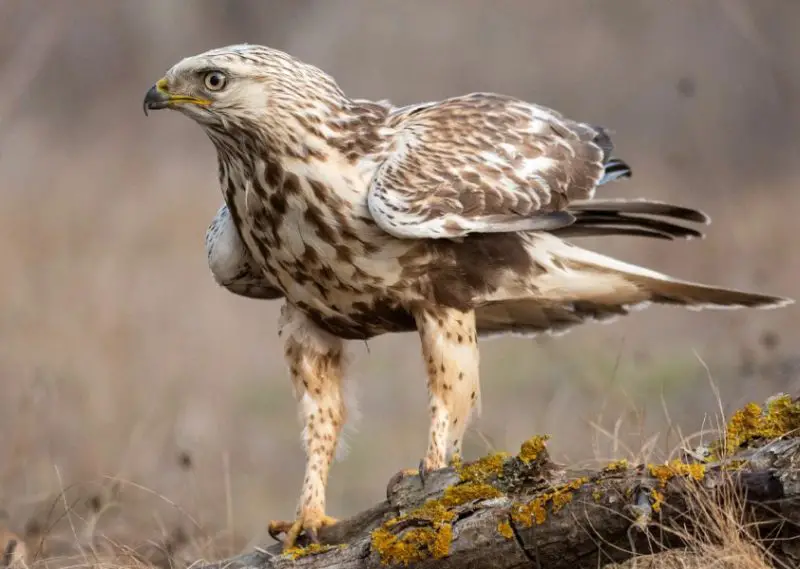
The Rough-legged Hawk is a striking winter visitor to North Dakota. It’s a large hawk, around 18 to 24 inches long with a wingspan of about 52 inches. One of its defining features is its feathered legs, which help it stay warm in cold environments. Its plumage is variable, but most have a pale underside with dark wrist patches and a black-banded tail.
This species is known for its hovering behavior while hunting, especially in windy open areas. It glides with wings raised in a slight dihedral and often hovers in place like a kestrel. Its flight style is buoyant and agile for such a large bird.
Rough-legged Hawks primarily feed on small mammals, especially voles and mice, which are plentiful in open grasslands and farm fields. Their ability to hunt from the air or a perch gives them versatility during North Dakota’s cold months.
You’ll typically find them in open fields, plains, and grasslands during the winter, often perched on fence posts or utility poles. They migrate from the Arctic tundra and begin arriving in North Dakota by October, staying until early spring.
Northern Harrier (Circus hudsonius)
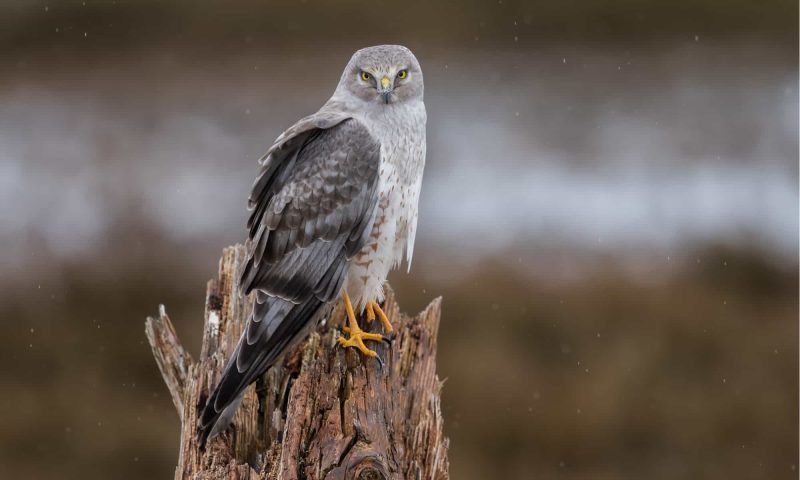
The Northern Harrier is a slim, medium-sized hawk with an owl-like face, long tail, and long wings held in a shallow V-shape during flight. Adult males are gray above and white below, while females and juveniles are brown. A key identification feature for all ages is the bright white rump patch near the base of the tail.
Northern Harriers are graceful flyers, often gliding low over fields and marshes as they search for prey. Their low, buoyant flight and distinctive wing shape make them easy to distinguish from other hawks. They are quiet and solitary hunters, often active at dawn and dusk.
These raptors rely heavily on hearing and vision to locate small mammals, especially voles and mice. They will also eat small birds and amphibians when available. Their facial disk helps funnel sound to their ears, similar to how owls hunt.
In North Dakota, they are common breeders and migrants, nesting in open wetlands, grasslands, and marshes. Look for them during the warmer months, especially from April through October. Some individuals may linger into early winter if food remains abundant.
Broad-winged Hawk (Buteo platypterus)
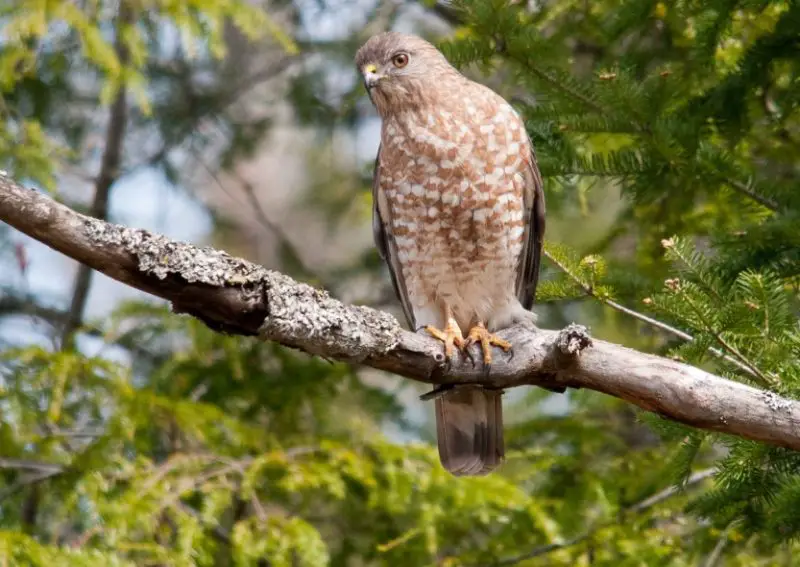
The Broad-winged Hawk is one of the smaller buteos, measuring 13 to 17 inches in length with a wingspan of about 33 inches. It has broad, pointed wings and a short tail with distinct black-and-white bands. Adults have reddish-brown heads and streaked chests, while juveniles show lighter coloring and streaking.
Broad-winged Hawks are best known for their impressive migratory behavior. In spring and fall, they travel in massive flocks called “kettles” that can number in the thousands. These migrations are usually seen in southern parts of North Dakota during peak flight times.
They primarily eat small mammals, frogs, lizards, and large insects. Broad-winged Hawks prefer to hunt from concealed perches within the forest, swooping down on unsuspecting prey in the underbrush.
In North Dakota, Broad-winged Hawks are migratory visitors, passing through wooded river valleys and mixed deciduous forests during spring and fall. They breed further east and north but can occasionally be spotted nesting near mature forested areas close to water.
Ferruginous Hawk (Buteo regalis)
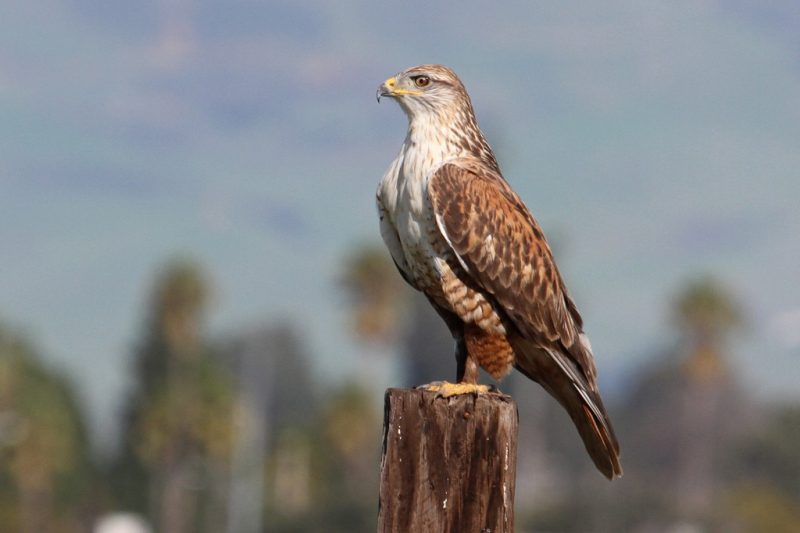
The Ferruginous Hawk is the largest hawk in North America and is known for its impressive size and pale coloration. It measures between 22 to 27 inches in length with a wingspan that can reach nearly 5 feet. Its plumage is mostly pale with rusty or rufous markings on the shoulders and legs, which are feathered down to the toes—an adaptation for cold environments.
This hawk has a broad wingspan and a heavy build, making it a powerful and steady flier. When soaring, the pale underwings and rusty markings are distinctive. It often perches on fence posts or poles in open country, scanning for prey.
Ferruginous Hawks primarily feed on mammals such as jackrabbits, ground squirrels, and prairie dogs. They hunt mostly on the ground, using keen eyesight to spot prey from a distance and then swooping down to capture it.
In North Dakota, Ferruginous Hawks are uncommon but breed in arid grasslands, open prairies, and rangelands. They are mostly found during the summer months, as they prefer open spaces with minimal tree cover for hunting.
Sharp-shinned Hawk (Accipiter striatus)
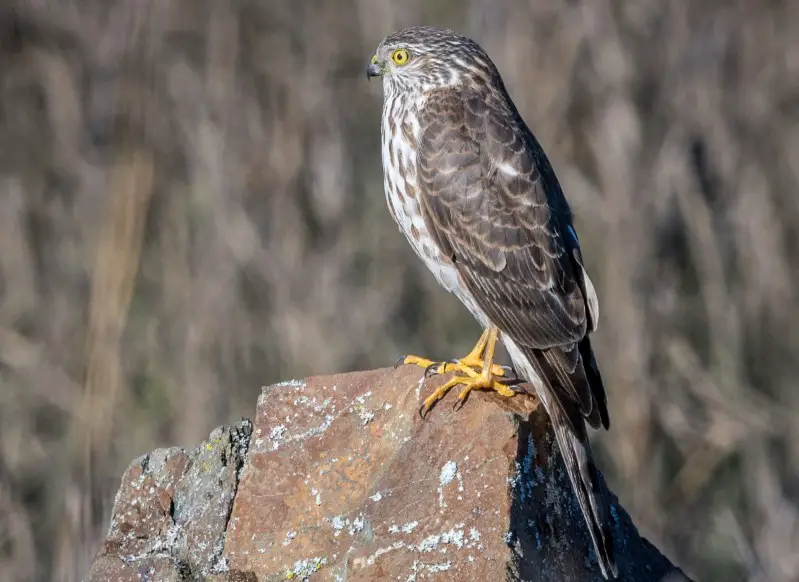
The Sharp-shinned Hawk is a small but fierce raptor, measuring about 10 to 14 inches in length with a wingspan around 24 to 30 inches. It has short, rounded wings and a long, narrow tail, which it uses skillfully to maneuver through dense forests and wooded areas.
This hawk is one of the most agile fliers, often darting through trees in pursuit of small birds. The plumage of adults includes a slate-gray back and reddish bars on the chest, while juveniles are browner with streaks. Sharp-shinned Hawks have a slender build compared to other hawks.
Their diet consists mainly of small birds like sparrows and finches, which they catch in flight. They hunt by stealth, often surprising prey with quick bursts of speed. These hawks are usually secretive and prefer thick forest edges and suburban woodlots.
In North Dakota, Sharp-shinned Hawks are most commonly seen during migration periods in spring and fall, although some may stay through the winter in suitable habitats.
Cooper’s Hawk (Accipiter cooperii)
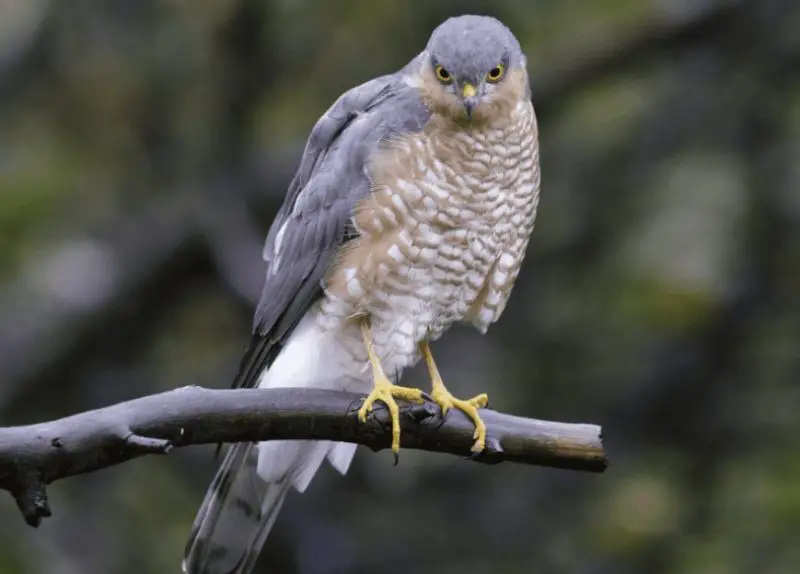
Cooper’s Hawk resembles the Sharp-shinned but is larger and more robust, measuring 14 to 20 inches long with a wingspan of 24 to 35 inches. It has rounded wings and a long tail with a rounded tip. Adults have a blue-gray back and a finely barred reddish chest, while juveniles are brown with streaks.
This hawk is an expert hunter of birds and small mammals, often preying on doves, pigeons, and squirrels. It uses stealth and surprise attacks, flying swiftly through trees and shrubs in wooded areas and suburban neighborhoods.
Cooper’s Hawks are adaptable and often found near human habitation, including parks and backyards where bird feeders attract prey. Their behavior includes swift, low-level flight and sudden bursts of speed to catch prey.
In North Dakota, Cooper’s Hawks are year-round residents in some areas, especially where wooded habitats and food sources are available throughout the year.
Northern Goshawk (Accipiter atricapillus)
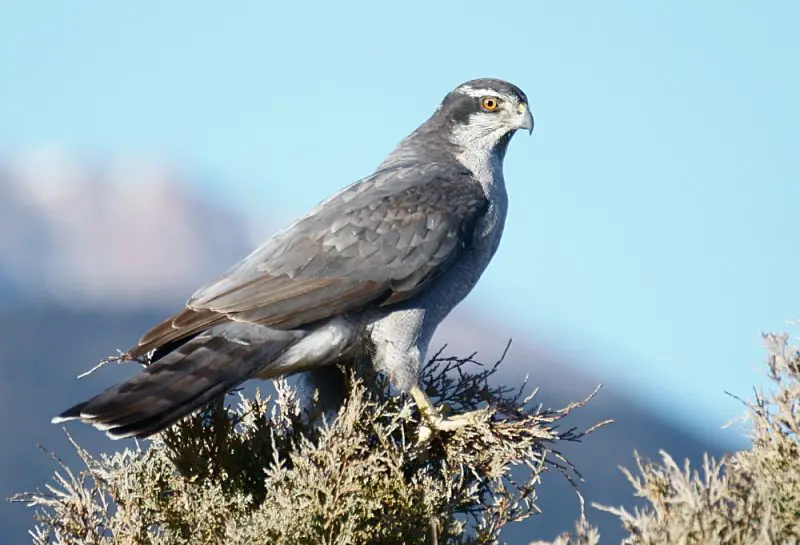
The Northern Goshawk is the largest and most powerful member of the Accipiter family found in North Dakota, measuring 20 to 26 inches in length with a wingspan up to 46 inches. It has a bold white eyebrow stripe, slate-gray upperparts, and a finely barred chest and belly.
This hawk is known for its strength and agility, capable of pursuing prey through dense forests at high speed. It hunts a variety of birds and mammals, including grouse, squirrels, and rabbits, often ambushing them with surprise attacks.
Northern Goshawks are elusive and secretive, preferring large, mature forests, especially boreal and mixed woodlands. Their aggressive nature is well known among birders and wildlife watchers.
In North Dakota, the Northern Goshawk is rare and mostly seen during winter as a visitor from northern breeding grounds. They are seldom encountered but are notable when spotted in forested northern regions.
Red-shouldered Hawk (Buteo lineatus)

The Red-shouldered Hawk is less common in North Dakota but can be occasionally spotted in wooded river valleys and forested wetlands. It measures about 16 to 24 inches in length with a wingspan of approximately 37 to 43 inches. Its plumage includes reddish shoulders and a striking black-and-white checkered pattern on the wings.
This hawk prefers hunting in forested environments where it perches quietly, waiting to swoop down on small mammals, amphibians, and reptiles. Its call is a distinctive, loud, and rolling “kee-ah” sound.
Red-shouldered Hawks often nest in deciduous or mixed woodlands near water sources such as rivers and swamps. They are territorial and maintain consistent nesting sites year after year when present.
In North Dakota, the Red-shouldered Hawk is a rare migrant or visitor, primarily found during migration or occasional summer sightings in suitable wooded habitats.
FAQ About Hawks in North Dakota
What types of hawks are commonly found in North Dakota?
North Dakota is home to a variety of hawks including the Red-tailed Hawk, Swainson’s Hawk, Rough-legged Hawk, Northern Harrier, Broad-winged Hawk, Ferruginous Hawk, Sharp-shinned Hawk, Cooper’s Hawk, Northern Goshawk, and Red-shouldered Hawk. Some are year-round residents while others are seasonal visitors or migrants.
When is the best time to see hawks in North Dakota?
The best time to observe hawks depends on the species. Many hawks, such as the Red-tailed Hawk, are present year-round. Swainson’s Hawks and Broad-winged Hawks are best seen during spring and fall migrations. Rough-legged Hawks are mostly winter visitors.
What habitats do hawks prefer in North Dakota?
Hawks in North Dakota occupy diverse habitats. Open prairies, grasslands, and farmlands are common for Red-tailed and Ferruginous Hawks. Forest edges and wetlands suit Northern Harriers and Red-shouldered Hawks. Migratory hawks often pass through wooded river valleys and mixed forests.
What do hawks eat in North Dakota?
Hawks primarily feed on small mammals like rodents, rabbits, and squirrels. Some species, like Swainson’s Hawk, also consume large numbers of insects during the summer. Birds, reptiles, and amphibians can also be part of their diet depending on the species and season.
Are any hawks in North Dakota endangered or protected?
Most hawk species in North Dakota are protected under the Migratory Bird Treaty Act, which safeguards them from hunting and disturbance. None of the common hawks in North Dakota are currently listed as endangered, but habitat conservation is important for their ongoing health.
How can I identify a Red-tailed Hawk?
Look for a large hawk with broad, rounded wings and a distinctive brick-red tail. They often perch visibly on poles or soar high in circular patterns. Their call is a distinctive, raspy “kee-eee-arr.”
Do any hawks migrate through North Dakota?
Yes, several hawks migrate through North Dakota, including Swainson’s Hawk, Broad-winged Hawk, and Rough-legged Hawk. They travel in large groups during spring and fall, sometimes forming large soaring flocks known as kettles.
Can I see hawks year-round in North Dakota?
Some hawks like the Red-tailed Hawk and Cooper’s Hawk can be seen throughout the year. Others, such as the Rough-legged Hawk, are primarily winter visitors, while Swainson’s and Broad-winged Hawks are summer visitors or migrants.

